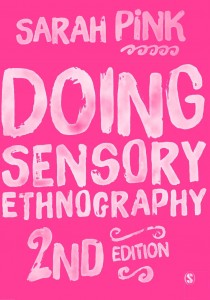Sensory Ethnography
Sensory Ethnography is an innovative methodology developed for understanding digital technologies and energy use in the home. It goes beyond conventional research that depends on what people say in interviews to instead encounter people as they live out the sensory, tacit, mundane and sometimes barely noticed elements of everyday life.

Find out more in Doing Sensory Ethnography by Sarah Pink
To do this, we used a series of innovative video methods that we report on below. These methods build on Sarah Pink’s earlier work around sensory ethnography, but also used new collaborative techniques that were developed specifically for the project.
1. The Home Video Tour
The video tour method has been developed over a series of research projects, since 1999, and continues to be developed in new ways in new contexts. We have discussed its trajectory in detail in a recent article, which makes special reference to our work with one of the LEEDR participants.
The video tour involves moving through the home, following and discussing with the participant as they guide the researcher through it. The aim is to gain an understanding of the ways in which the notion of ‘home’ is created for and by them.
The video tour was our first route into exploring the sensory aesthetic of home with our participants – that is, how they made their homes ‘feel right’. The video tour enabled us to gain a sense of how participants interwove their everyday activities in the home into each other as we engaged with the home through its material and sensory properties. Rather than simply asking participants in an interview about different domestic ‘practices’, the Home Video Tour helped us document domestic environments and activities in a richer and more nuanced way.
2. Video Re-enactments
Re-enactments also formed an important part of our research methodology. We asked participants to re-enact their routines of getting up in the morning, going out, coming home and going to bed at night.
We choose these as we had a hunch that they would be key transition moments in the day in relation to energy use, and we were right. They were also important as they showed how these routines were habitual, known in the body, rather than deliberately thought through. By filming these routines, we were able to investigate the meaning and importance of these habitual, unspoken elements of daily practices. We were also able to gain an understanding of how people used elements of improvisation within them.
Our participants’ bed time routines were interesting points of comparison in this regard; they had many similarities yet were packed with improvisory and idiosyncratic habits, which we are certain will change over time. Compare the bed time routines of these participants to see how they varied and how each person improvised in their own ways.
To develop these re-enactments, we simply asked our participants to show us how they normally performed these routines in their everyday lives. Some participants performed longer processes than others, but they all maintained and controlled a level of privacy they wanted to keep, given that the home is an intimate space.
3. Video recording everyday activity
In addition to recording people as they re-enacted practices outside of the normal rhythm or flow of the day, we often filmed them acting out these practices as they actually went about them. Our researchers spent up to 2 days in each participant’s home, and as such we had many opportunities to observe participants going about their daily activities without any specific instruction.
Within these daily activities, we began by looking for signs of the ‘practices’ we decided would be interesting – media use, laundry, cooking, showering and heating. However we were also aware that in fact when lived out in the home these practices would be dispersed, and mixed up with each other and other things and processes. Indeed we already started to see evidence of this during our video tours.
Our ‘practice’ studies confirmed this. It was difficult to study any practice in isolation, and when we returned to participants’ homes we realized that in fact we were researching ongoing human activity as it happened, and learning about how the different tasks that make up these practices are interwoven in everyday life. We eventually decided that although the concept of practices had been useful for us as an entry point into our research, and in order to communicate across our large interdisciplinary project team, we would not recommend practices as design categories. Rather, we found we needed to go beyond these analytical units and build up new categories from our ethnography that would fit with our participants’ lives.
4. Methods for the messiness of everyday life
These methods proved successful in being able to navigate and explore the complex interplays between people, their homes and the practices that are performed there.
Rather than simply interviewing participants, the use of video in these methods allowed us to investigate the unspoken, habitual elements of daily practices that participants may not have known (or been able to) mention. It brought us closer to how everyday life is actually lived out and how energy-related activities are situated in the home. Specifically the re-enactments helped to bring to the fore some important contingencies and interrelations between people’s routines, social, structural and temporal contexts. We learned about the ways in which people sensed each other’s presence and activities around the home and integrated their own activities accordingly (e.g. washing machine use at night). We learned how media use marked or accompanied other energy-related activities, and how activities were scheduled and timed in particular ways to fit in with family life. As well as providing insights in their own right, the video clips also formed the basis for ethnographic narratives that became tools in the LEEDR design process.




